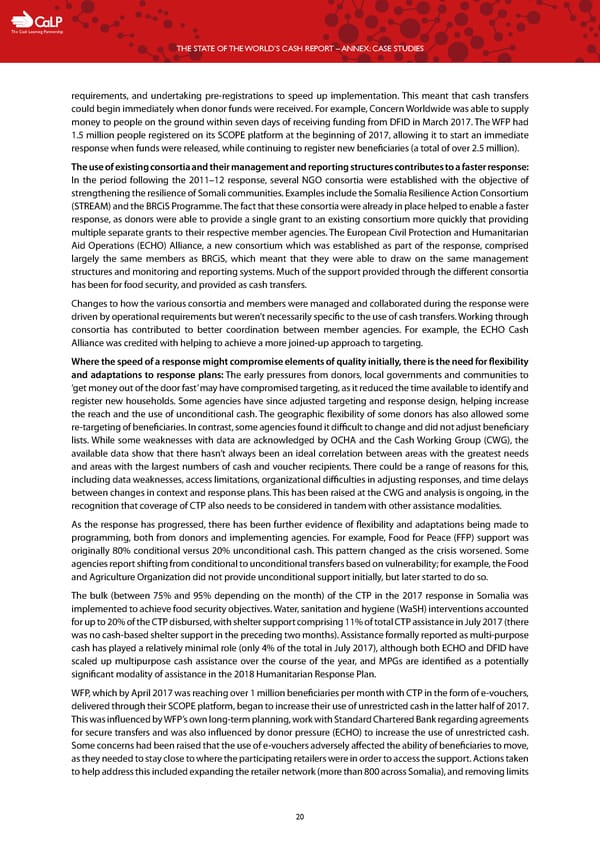C The Cash Learning Partnership THE STATE OF THE WORLD’S CASH REPORT – ANNEX: CASE STUDIES requirements, and undertaking pre-registrations to speed up implementation. This meant that cash transfers could begin immediately when donor funds were received. For example, Concern Worldwide was able to supply money to people on the ground within seven days of receiving funding from DFID in March 2017. The WFP had 1.5 million people registered on its SCOPE platform at the beginning of 2017, allowing it to start an immediate response when funds were released, while continuing to register new beneficiaries (a total of over 2.5 million). The use of existing consortia and their management and reporting structures contributes to a faster response: In the period following the 2011–12 response, several NGO consortia were established with the objective of strengthening the resilience of Somali communities. Examples include the Somalia Resilience Action Consortium (STREAM) and the BRCiS Programme. The fact that these consortia were already in place helped to enable a faster response, as donors were able to provide a single grant to an existing consortium more quickly that providing multiple separate grants to their respective member agencies. The European Civil Protection and Humanitarian Aid Operations (ECHO) Alliance, a new consortium which was established as part of the response, comprised largely the same members as BRCiS, which meant that they were able to draw on the same management structures and monitoring and reporting systems. Much of the support provided through the different consortia has been for food security, and provided as cash transfers. Changes to how the various consortia and members were managed and collaborated during the response were driven by operational requirements but weren’t necessarily specific to the use of cash transfers. Working through consortia has contributed to better coordination between member agencies. For example, the ECHO Cash Alliance was credited with helping to achieve a more joined-up approach to targeting. Where the speed of a response might compromise elements of quality initially, there is the need for flexibility and adaptations to response plans: The early pressures from donors, local governments and communities to ‘get money out of the door fast’ may have compromised targeting, as it reduced the time available to identify and register new households. Some agencies have since adjusted targeting and response design, helping increase the reach and the use of unconditional cash. The geographic flexibility of some donors has also allowed some re-targeting of beneficiaries. In contrast, some agencies found it difficult to change and did not adjust beneficiary lists. While some weaknesses with data are acknowledged by OCHA and the Cash Working Group (CWG), the available data show that there hasn’t always been an ideal correlation between areas with the greatest needs and areas with the largest numbers of cash and voucher recipients. There could be a range of reasons for this, including data weaknesses, access limitations, organizational difficulties in adjusting responses, and time delays between changes in context and response plans. This has been raised at the CWG and analysis is ongoing, in the recognition that coverage of CTP also needs to be considered in tandem with other assistance modalities. As the response has progressed, there has been further evidence of flexibility and adaptations being made to programming, both from donors and implementing agencies. For example, Food for Peace (FFP) support was originally 80% conditional versus 20% unconditional cash. This pattern changed as the crisis worsened. Some agencies report shifting from conditional to unconditional transfers based on vulnerability; for example, the Food and Agriculture Organization did not provide unconditional support initially, but later started to do so. The bulk (between 75% and 95% depending on the month) of the CTP in the 2017 response in Somalia was implemented to achieve food security objectives. Water, sanitation and hygiene (WaSH) interventions accounted for up to 20% of the CTP disbursed, with shelter support comprising 11% of total CTP assistance in July 2017 (there was no cash-based shelter support in the preceding two months). Assistance formally reported as multi-purpose cash has played a relatively minimal role (only 4% of the total in July 2017), although both ECHO and DFID have scaled up multipurpose cash assistance over the course of the year, and MPGs are identified as a potentially significant modality of assistance in the 2018 Humanitarian Response Plan. WFP, which by April 2017 was reaching over 1 million beneficiaries per month with CTP in the form of e-vouchers, delivered through their SCOPE platform, began to increase their use of unrestricted cash in the latter half of 2017. This was influenced by WFP’s own long-term planning, work with Standard Chartered Bank regarding agreements for secure transfers and was also influenced by donor pressure (ECHO) to increase the use of unrestricted cash. Some concerns had been raised that the use of e-vouchers adversely affected the ability of beneficiaries to move, as they needed to stay close to where the participating retailers were in order to access the support. Actions taken to help address this included expanding the retailer network (more than 800 across Somalia), and removing limits 20
 The State of the World's Cash | Case Studies Page 21 Page 23
The State of the World's Cash | Case Studies Page 21 Page 23